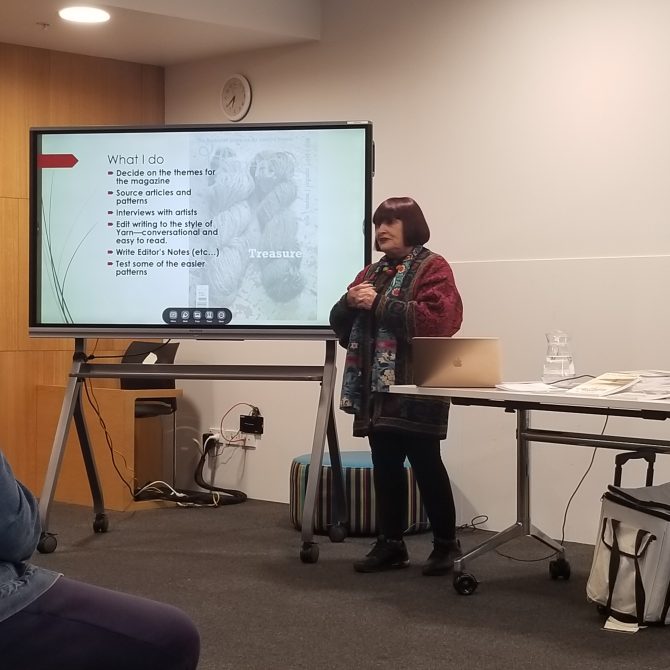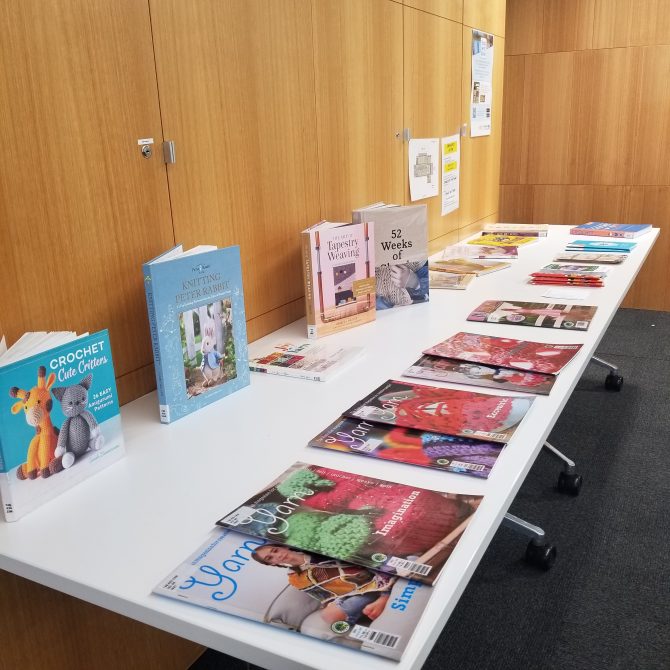Sally reports back from the last Craft Snippets event at Upper Riccarton Library. The next event on Wednesday 29 May will feature needle-felter Diane Renwick.
“Yarny people come to listen to my yarn”, and we did as we spent a lovely time listening to Dr Rie Natalenko, editor of Yarn magazine. Rie likes to call her talks ‘yarning’, because it is what she does in life - telling stories, yarning, and crafting yarn. Rie talked about three types of yarning – being the editor of Yarn magazine, yarning on cruise ships, and her books.
Rie started out as an educator, teaching in schools, university, in the community and for corporations. She did a doctorate in creative art majoring in writing and along the way experimented with a lot of creative arts.
Books and writing
Her books include two about family history, “The Family Memory Project” and “The Family Message Book”. “The Family Memory Project” is about gathering family stories and the importance of capturing precious family stories before you lose a loved one. “The Family Message Book” is a book that you fill in with all the information you would like someone to know when you pass away.
“Share Your Skills”, also by Rie, is about how to share your craft skills. We can spend so much money going to workshops, run by brilliant practitioners who simply can’t teach. This book is about how to share your skills.
Rie also does business writing, how to do resumes, how to write your own book, plus of course she is the editor of Yarn magazine.
Editor Yarn magazine
Yarn magazine is part of Artwear Publications which also publishes Vintage Made, Embellish, Textile Fibre Forum and Felt.
As the editor, Rie first decides on a theme for the magazine. Each one has a different theme, the most recent one was ‘Inspiration’, the next will be ‘Contrasts’ and then ‘Conversations’. Rie sources all the articles and patterns. First port of call are the regular contributors. Rie sends them the theme and they think about what they can write that will fit. Other people can write in with ideas for a pattern or an article. Also, Rie meets designers and artists who might write a ‘how to’ article, or sources topics such as wellness through crafting etc. Rie interviews artists and designers. Rie recently interviewed Joyce from Joyce’s Crochet Room who crafts tiny crochet earrings and sells them in Riccarton Mall.
The style of writing in the magazine is informal and conversational. Quite different from some other magazines. Rie likes that it is friendly.
Rie writes editor notes and if someone drops out at last minute, finds something to fill the gap. Or turns to a trusted contributor to help fill the gap.
All the patterns in the magazine are tested. Rie will test the easier patterns if she has time. The patterns are also sent to a tech editor who tests them all.
Rie liaises with the photographer. The photographer is in Australia and so they meet over zoom.
Decisions are made as to where each article will go in the magazine, leaving space for advertisements. It is a tricky juggling act, but finally a magazine dummy is made. After that it is sent to the graphic designer. Then it is back for a double check. Sometimes small things are still picked up. It goes back and forth until “everyone is satisfied”.
There are opportunities available. Rie needs patterns. If you are a designer, Rie would like knitting, crochet, macrame and weaving patterns. Anything to do with yarn. Rie is more than happy to look at an article or pattern and say if it can go in the magazine. There is a fiction section in each magazine, but Rie has a well published author who does this piece. Rie is particularly interested in sourcing articles on tablet weaving, hairpin lace and other unusual yarn related crafts.
Bringing crafts to cruises
Cruising is another pastime that keeps Rie busy, being a speaker on cruise ships, part of the edu-tainment. Rie started out as a craft instructor on the cruises. However, the problem with being a craft instructor is that you supply all the materials and have projects that suit a complete novice and can be finished in an hour. Also, you need to provide 50 kits but only 5 might be used, you travel with your supplies and pay for everything. Rie watched speakers on stage and thought that seemed easier. Being used to giving talks to Probus and Rotary, Rie already had a wealth of talks to use.
There are advantages and disadvantages. The cruise ship doesn’t pay you. But you do get a free cruise and you can take a companion as long as they don’t mind sharing with you. The companion pays a fraction of the cost.
Depending on the cruise line, you may need to submit 40 topics and the cruise line picks what they want. You do the research, and they expect you to know your topic well.
With some cruise lines, you get to escort the guests on excursions sometimes. If there is a tour you are interested in, you can pop your name down to be an escort. That means counting people on and off the bus and not losing anyone.
One disadvantage is that you must be ‘on’ all the time. Sitting at breakfast someone might come over to talk to you and you must be friendly and welcoming and chatty.
If you are a success, they will invite you back. Rie has a 42-day cruise around the Mediterranean next year. “You can’t say no to that. It’s a hard job…but someone has to do it!”
How do you become a cruise speaker? Well first off you need to have an agent. Write to them saying what you can do, and they will tell you if it is worth pursuing. Some agents will give you a challenge – come up with 10 topics by tomorrow and email them. Then they may say, numbers two and six, prepare a 10 min presentation on those topics with a powerpoint.
There are qualifications you can do for being a six star cruise ship speaker and Rie did these during Covid.
A family history of crafting
Someone asked how Rie got into craft. Rie’s grandmother was a lace maker in Nottingham. Her mother worked and would drop Rie off at her grandmother’s work during the day. Rie would sit on the floor on a cushion and watch her grandmother. Her grandmother oversaw a lace making factory and her job was to the fix mistakes. Her grandmother knew all the patterns and would fix the mistakes by hand. And as we know often fixing the mistake can be harder than doing it the first time. Rie loved the bits of lace and yarn, and her grandmother taught her to knit and crochet.
Someone asked if Yarn magazine had changed since Covid. Yes, Rie said, with people being home and taking up new crafts. The demographic for Yarn though has always been quite young. People have the idea that craft is for grannies, but they forget that we wore 60s miniskirts, and no one wants to wear grandma’s jumper.
Yarn magazine is not as widely available in New Zealand as in Australia, so Rie encouraged us to pop into your local newsagents and ask for it. And of course it is here at your local Library.
New craft titles and local resources
Angela pulled out some great magazines and books for the evening.
Items shared at our March 2024 gathering. You can put a hold on any of these titles.
Sally did a roundup of crafty events happening in Christchurch and people suggested some new places to check out, including,
- Unwind & knit with me in Bishopdale
- Wild Earth Yarns
- Willoughbys / The Wool Shop Rangiora
- Broomfields & Co.
Sally,
Upper Riccarton Library
Join us for our next Craft Snippets event on Wednesday 29 May with needle-felter Diane Renwick.






Add a comment to: Craft Snippets: Yarn magazine editor, Dr Rie Natalenko